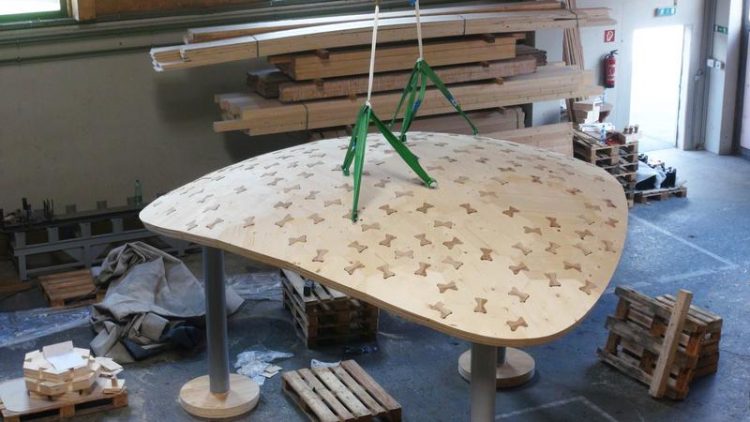Supported by software, Kaiserslautern architects assemble wooden dome like a puzzle

Only wood is used, also connecting elements are made of natural material. Credits: Robeller
People have been using wood for constructing buildings material for thousands of years. While the material has tended to fall behind in recent years, demand has been rising again recently. “New treatment methods also play a role here that make wood better usable as a building material,” says Assistant Professor Christopher Robeller, who heads the “Digital Timber Construction DTC” working group at the TUK in the Faculty of Architecture.
Together with his team, Robeller has developed software that can also be used to produce more complex buildings and components from wood. The architects rely only on the natural material, other building materials are no longer necessary.
“Our computer programme first calculates how many individual parts our construction should ideally consist of,” explains the Professor. “It also determines which shapes these should preferably have and in which way they have to be assembled.” Various factors such as statics, geometry and joining play a role here, which ultimately guarantee the stability of the end product. “A milling machine then implements the software specifications and cuts the corresponding wooden parts to size,” he continues. Similar to a puzzle, the individual pieces can easily be put together afterwards.
Robeller and his team recently used the process to build a dome with a diameter of four meters. “For the larger parts, we used cross laminated boards made of coniferous wood. This standard building material is relatively inexpensive and has a very good strength-to-weight ratio,” says Robeller. “The smaller connecting elements, on the other hand, are made of hardwood.”
The connecting parts always have the same shape. In order to connect the larger wooden parts in a stable way, the software also takes into account how and in which direction the connectors must be optimally installed at which point. All in all, the team assembled the 58 components in just a few hours. Previous methods have not made it possible to build such a vault solely from wood.
Although there are other domes made of the natural material, however, the individual parts still had to be connected with nails or screws. “In our process, we do not need a complex and expensive substructure,” explains the architect. “The only tool needed is a hammer to insert the connectors. And a few drops of adhesive to act as a safety device.” Robeller and his team assume that dome roofs with a diameter of 30 meters can be realized with this technology.
The construction industry could use the process with the help of an app. In the future, it could thus use digitally prefabricated components for buildings and assemble them quickly and precisely. In addition, wood will play an increasingly important role as a sustainable building material.
The Kaiserslautern architects realized the experimental construction together with the following partners from industry: x-Fix, the manufacturer of the wood connecting elements, HOKU OG CNC Fertigung, the Austrian wood panel manufacturer Hasslacher Norica Timber and the company Gemson, also from Austria, which provided the solid wood supports for the dome prototype.
Timber construction has long been a research focus at the TUK. In the “T-Lab – Holzarchitektur und Holzwerkstoffe” [T-Lab – Wood Architecture and Wood-Based Panels], a competence centre for wood, four working groups from the specialist area of architecture are researching how wood can be used to a greater extent in the construction industry in the future. New digital technologies also play an important role here. The area of research is located at the interface of architecture, computer science, civil engineering and manufacturing technology.
The team of the TU Kaiserslautern recently presented the wooden dome at the wood fair in Klagenfurt. A video showing the building of the dome is available at www.architektur.uni-kl.de/dtc/2018/08/29/holzmesse-klagenfurt/
Assistant Prof Dr Christopher Robeller
Digital Timber Construction DTC
Phone: +49 (0)631 205-3994
E-mail: christopher.robeller(at)architektur.uni-kl.de
http://www.architektur.uni-kl.de/dtc/2018/08/29/holzmesse-klagenfurt/
Media Contact
All latest news from the category: Architecture and Construction
Newest articles

First-of-its-kind study uses remote sensing to monitor plastic debris in rivers and lakes
Remote sensing creates a cost-effective solution to monitoring plastic pollution. A first-of-its-kind study from researchers at the University of Minnesota Twin Cities shows how remote sensing can help monitor and…

Laser-based artificial neuron mimics nerve cell functions at lightning speed
With a processing speed a billion times faster than nature, chip-based laser neuron could help advance AI tasks such as pattern recognition and sequence prediction. Researchers have developed a laser-based…

Optimising the processing of plastic waste
Just one look in the yellow bin reveals a colourful jumble of different types of plastic. However, the purer and more uniform plastic waste is, the easier it is to…



